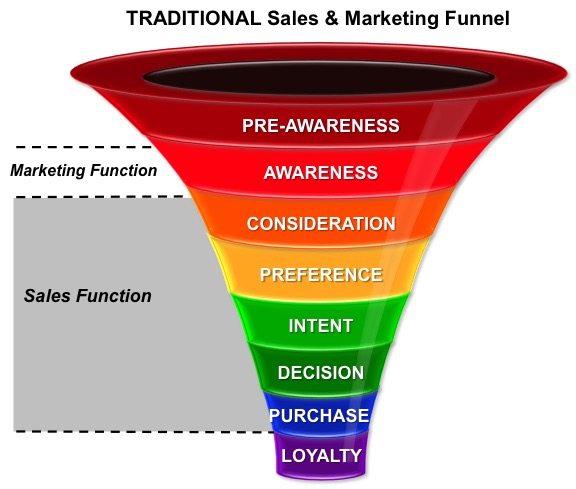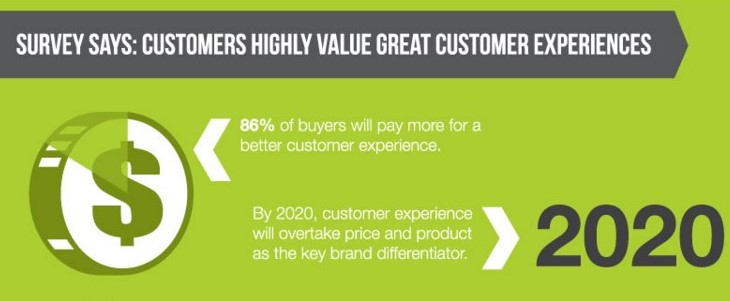Conventional marketing tells us that every prospect goes through a specific journey on their way to becoming a customer. Experts have recommended that we map each customer journey in an effort to better understand how customers interact with your brand, learn about your products, and touch your marketing materials throughout that journey. Ultimately, you will use this information to strengthen the experience of each future customer by providing a better, more refined way to develop a relationship with your brand in a way that is optimal for them.
The LeadsRx attribution software measures any and all channels, providing an unbiased look at what channels are working, and how they are working together, to create customer paths to purchase.
To learn more about multi-touch attribution and how the insights from cross-channel data can help you improve return on ad spend, please book a demo today.
The idea behind customer journey mapping is a good one. It’s always the right idea to better understand our customers. But as the internet has grown and companies have less control over the actual process that customers undertake in researching a new product, customer journey maps have become harder to put together. The task of simply tracking what actions your customers take is hard enough but to make enough sense of them to put them into a definable journey is nearly impossible.
We used to say that the customer journey map looked like this:

Source: Alore.io
Often represented as a funnel, the customer journey was reliably seen as a set of steps that every customer took on their way to purchasing. Since companies were able to guide customers through these steps reliably, it made sense to create processes and workflows around those steps, walking the customer toward the positive purchasing decision. Aspects of this funnel are still intact in today’s customer journeys, but the order in which things happen can differ from one customer to another.
Today, the journey looks more like this:

Today, the journey that customers undertake on their way to making a purchase isn’t so linear. Sure, there are still aspects of the B2B buying process in a traditional sales funnel that are present in CEB’s analysis of a realistic buying journey pictures above, but the process, on the whole, feels totally different to the end user.
These steps happen in an unpredictable order that are wholly dependent on the process that the individual or company’s buying team goes through on their own whims. B2B sales and marketing teams are forced to be more adaptive, catering to the process of each customer individually instead of forcing each customer down an unenforceable funnel.
There are a few key ways in which the customer journey has changed in the last decade. These changes include:
Buyers See Buying As a Series of Unique Tasks, Not a Journey
Customers don’t see the process that they go through on their way to buying as a “customer journey.” Especially B2B buyers. That’s far too epic of a categorization of the process in the eyes of a customer and your average buyer is much more pragmatic than the name suggests.
They don’t see it as a journey. They see it as a series of tasks that they have to complete in order to find a solution that best solves the problem they are looking to solve.
These tasks include but are not limited to:
- Evaluating multiple solutions to create a baseline list that meets their initial requirements.
- Evaluating the features to ensure the solution not only provides what they need but can be integrated into their existing processes.
- Determining whether or not a solution fits within their budget.
- Trying a demo of the solution to better understand usage and workflows as it applies to their needs.
- Evaluating the solution with their internal teams and receive feedback.
- Evaluating the viability of customer support from each provider to ensure a smooth transition.
- Evaluating the solution with other decision-makers and receive sign-off on the purchasing decision.
These are just a few of the dozens of different tasks that your B2B buyer has to undertake when shopping for solutions. They aren’t just performing these actions for a single solution, either. At the same time, they are performing these actions for all of the solutions that they believe meet their initial criteria, removing options from the list as they go.
So, no, they don’t see it as a customer journey. It’s impossible to see it as a straight line from Point A to Point B when evaluating several different products in this way. These steps are often disconnected, happening out of order as they simply try to make their way through the process of understanding each solution and determining which will be viable for their company.
Research is Multi-Channel and Multi-Format
According to research from SiriusDecisions, 67% of the buyer’s journey is performed digitally. This means that it is performed on their own terms, with actions taking place as they see fit based on their needs, not based on the instructions provided by one solution of many that they are evaluating at any given time.
Customers are generally aligned in their preferences when it comes to B2B buying. They like to be left up to their own devices for a majority of the researching stage. In this stage they will:
- Seek out unbiased opinions from third-parties and current customers.
- Consult with internal and external sources about the options available to them.
- Better understand the solutions that are on their list for consideration.
- Check into the reputations of the companies that offer the solutions that they are considering.
Most customers start with a Google search. 72% of buyers turn to Google for help researching. But from there, it is hard to know where the buyer’s research will take them.
They will view your website. They might read your blog posts, download your whitepapers and lead magnets, or ask questions about solutions on social media. They’ll read reviews on third-party websites and watch review videos on YouTube. They’ll scour LinkedIn, Facebook, and Twitter for discussions about your product or competing products in your industry.
They’ll use every resource they have at their disposal to make an informed decision. Often the health of their company and their reputation may be on the line with this choice. They don’t want to encourage investment in a solution that ultimately makes them look bad, and we can’t blame them for that.
Customers Interact with Sales Reps Later
To further display how companies have less control of the journey that their customers take throughout the buying process, look no further than how often (and early) customers interact with sales reps compared to previous years.
70% of the journey a customer takes is complete before the average buyer reaches out to sales. In fact, many customers will do everything that they can to avoid speaking to a sales rep before they consider themselves 100% ready. To push them toward hopping on the phone too early is seen as pushy salesmanship and can do more to hurt your chances of conversion than help.
Instead of reaching out to a sales rep early to understand the product, most customers want to handle the research phase on their own. That doesn’t mean that companies should take a back seat in this phase.
You still have to make content and materials that are relevant to their choice readily available to them throughout their research process. Publishing blog posts, whitepapers, eBooks, case studies, and email sequences that help to guide them through the minute-journeys that they undertake in the research phase are not just helpful, they are required to stand out from the competition. They help to facilitate a better experience to the buyer. Often, the company that can best help customers understand their product will be in the best position to earn the sale.
Relationships and Experiences Have a Huge Effect
Just because customers want to interact with sales reps later than they would have two decades ago doesn’t mean that they don’t want companies to go the extra mile to cater to them as they make their decision. The overall experience that they customer has throughout the process plays perhaps the biggest role in their decision to buy (or not to buy) your solution.
Take a look at these customer experience stats that show just how important it is to your average customer:
- 83% are willing to pay more for a great customer experience.
- 73% of buyers point to their experience as an important factor in their purchasing decision.
- 65% say that a positive experience with a brand was more impactful than great advertising.
Experience is only going to become more important to customers. As more companies use automation to drive their advertising and marketing campaigns, differentiating between solutions will become more difficult for B2B buyers. According to a recent study from Walker, by the year 2020, customer experience will overtake price and product as the key differentiator of brands.

Source: SuperOffice
By giving your customers access to all of the content and information that they need in the research phase and allowing them to come into interactions with sales reps more informed, you will deliver a better experience and position yourself to build meaningful relationships with prospects as they come through your sales pipeline.
Decision-Making is Crowdsourced
Another big reason why B2B customer journeys are less linear today than ever before is the fact that decision-making has become increasingly complicated. No longer is a single person assigned to the evaluation and determination process. Most B2B companies take feedback and opinions from multiple stakeholders into account when they make a decision. More stakeholders are being brought into the fold than ever before, which means that companies need to position their solution for a wide variety of needs and job titles.
According to Gartner, in enterprise tech sales, the average buying team includes 7 different stakeholders. Each of these stakeholders may undergo their own evaluation process for your product, often starting at the beginning as they are brought into the fold. Different stakeholders will have their own interests and concerns, making it nearly impossible to outline a general journey that you’d expect any company to undergo. To try to account for a wide range of different job roles and requirements can be difficult, and further illustrates just how non-linear the B2B buying journey has become in recent years.
Why Attribution is So Important in the Non-Linear Customer Journey
So with buying journeys being more hands-off, involving more people, and completed in a different order than most would expect — how do you go about measuring the effectiveness of the marketing content and collateral that played a role in the sale?
Throughout your typical B2B customer journey, you might have seven different stakeholders that all interact with different blog posts, whitepapers, case studies, and marketing videos on their way to evaluating whether your solution will meet their particular needs. They may have found out about your product through a google search, advertisements, or word-of-mouth on social media. How do you measure who viewing which piece of content played what role in their ultimate decision to purchase? Without help attributing the decisions that they make to specific pieces of content, you’ll just be making marketing decisions in the dark.
LeadsRx helps you to employ an ongoing process, monitoring all aspects of your inbound and outbound marketing programs. We help you to track what content was viewed, who did the viewing, and assign a value that each piece played in their overall decision to buy your solution.
Our Enterprise Attribution Platform can help your company improve your B2B sales and marketing in a variety of ways:
- More leads from your current resources. Our system will help you to identify what areas of your marketing programs are working and optimize your ad spend to focus on those areas. We’ll collect advertising costs, collect behavior data for conversions, use multi-touch attribution models to identify influential interactions, improve the cost of customer acquisition, and ultimately help you to reallocate your ad spend toward better-performing programs.
- Better understand the non-linear customer journey. Our system lets you know and understand the path that your prospects take prior to conversion. Our system will help you to define conversion points (like form completions and content views), collect and analyze data related to all touchpoints, review the journeys that specific customers took on their way to conversion, and review aggregate journey data to provide more insight into the path your typical customer takes.
Our system unlocks the ability for you to better understand the journey that each individual customer takes, conveying similarities between the non-linear paths that all of your customers take together. Using multi-touch attribution models, you can understand which pieces of content had the most impact on buying decisions and re-focus your efforts to maximize the effect of those touchpoints.
Want to see what LeadsRx can do for you? Sign up for your free demo today.

